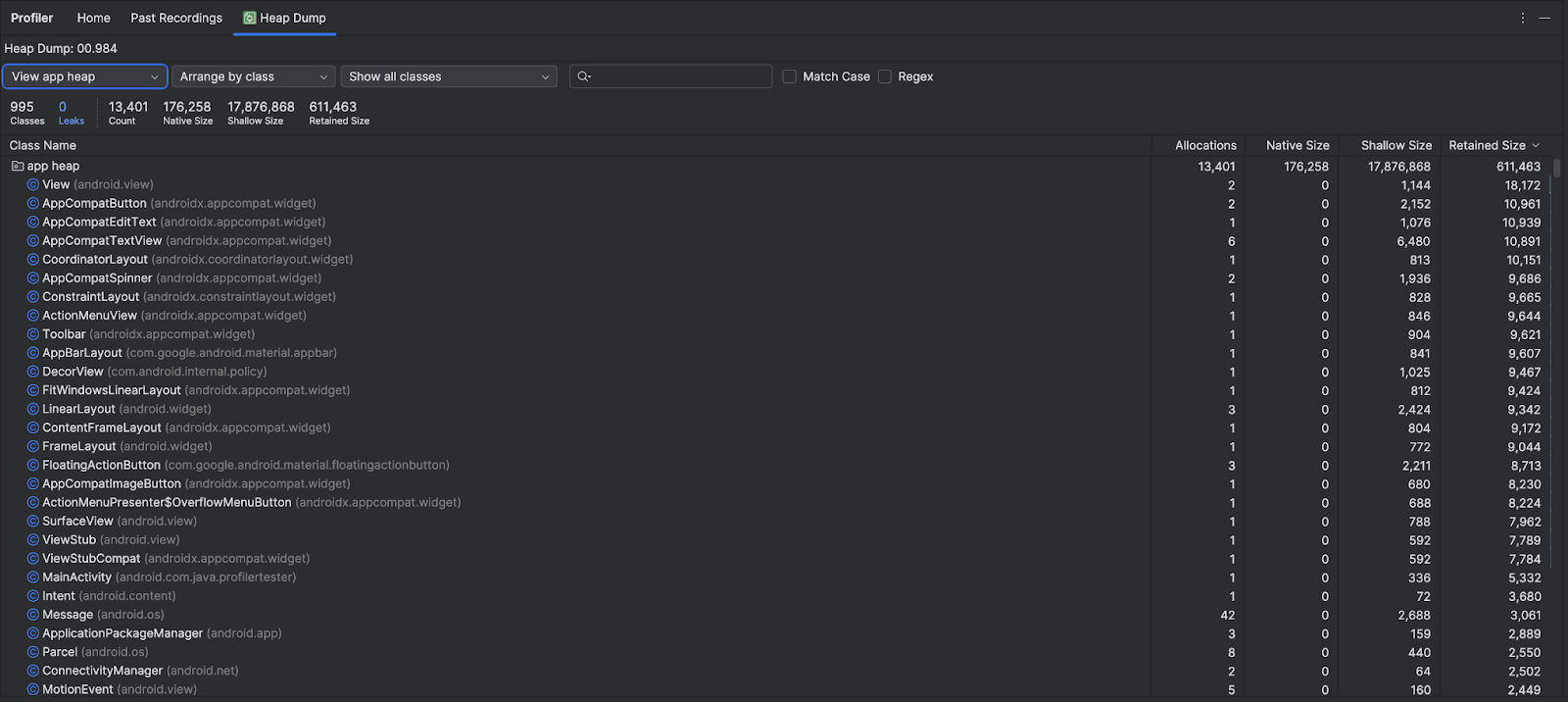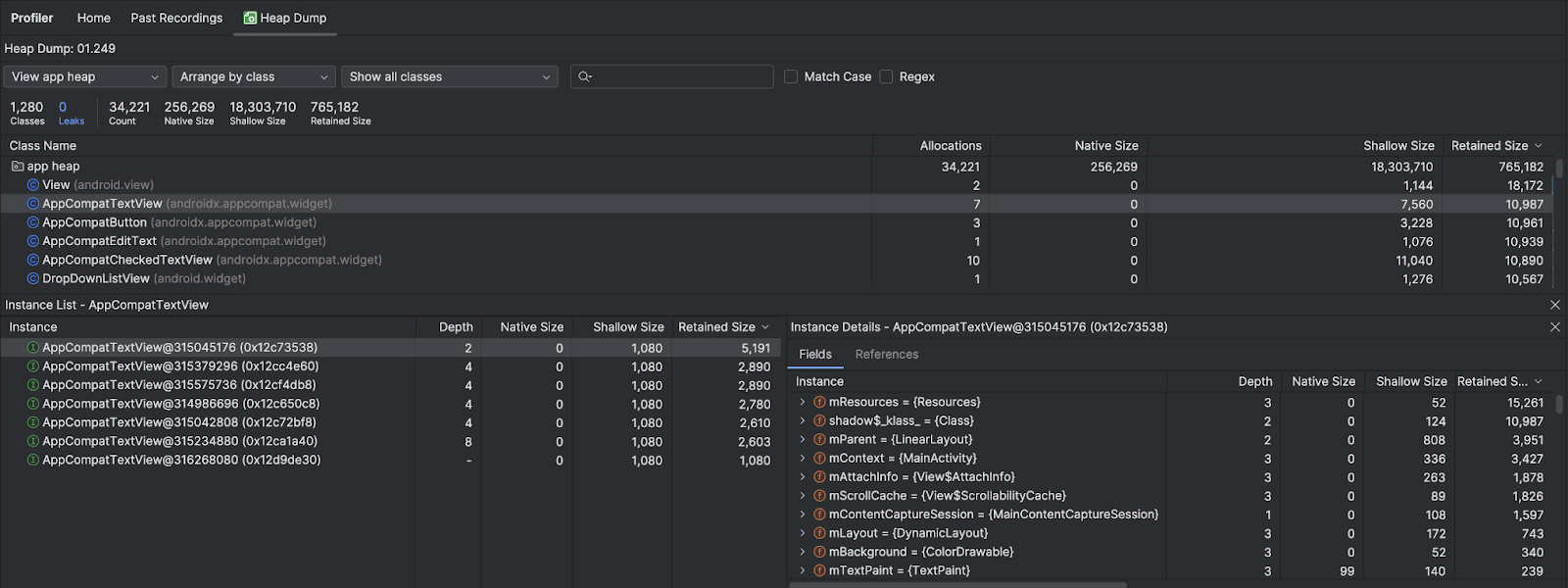捕获堆转储,查看您的应用中哪些对象 捕获时间,并识别内存泄漏或内存分配行为 以致应用卡顿、卡顿甚至崩溃。在长时间的用户会话后,获取堆转储尤其有用,因为它可能会显示不应再位于内存中的对象。
本页介绍了 Android Studio 提供的用于收集和分析堆转储的工具。或者,您可以从命令行使用 dumpsys 检查您的应用内存,还可以在 Logcat 中查看垃圾回收 (GC) 事件。
为什么应分析您的应用内存
Android 提供了托管内存环境 - 当 Android 确定您的应用不再使用某些对象时,垃圾回收器会将未使用的内存释放回堆中。虽然 Android 查找未使用内存的方式在不断改进,但对于所有 Android 版本,系统都必须在某个时间点短暂地暂停您的代码。大多数情况下,这些暂停难以察觉。 不过,如果您的应用分配内存的速度比系统回收内存的速度快,则当回收器释放足够的内存以满足您的分配需要时,您的应用可能会延迟。此延迟可能会导致您的应用跳帧,并使系统明显变慢。
即使您的应用未表现出变慢,但如果存在内存泄漏,应用在转到后台运行时,仍可能保留相应内存。此行为会导致系统强制执行不必要的垃圾回收事件,因而拖慢系统其余部分的内存性能。最终,系统将被迫终止您的应用进程以回收内存。然后,当用户返回您的应用时,应用进程必须重启 完全没有问题
如需了解可减少应用内存使用量的编程做法,请阅读管理应用内存。
堆转储概览
如需捕获堆转储,请执行以下操作: 选择 Analyze Memory Usage (Heap Dump) 任务 (使用 Profiler: run 'app' as debuggable (complete data))来捕获堆 dump。在转储堆期间,Java 内存量可能会增加 临时性。这很正常,因为堆转储与 并且需要一些内存来收集数据。捕获堆转储后,您会看到以下内容:

类列表会显示以下信息:
- Allocations:堆中的分配数。
Native Size:此对象类型使用的原生内存总量(以字节为单位)。您会在此处看到采用 Java 分配的某些对象的内存,因为 Android 会针对某些框架类使用原生内存,例如
Bitmap。Shallow Size:此对象类型使用的 Java 内存总量(在 字节)。
Retained Size:为保留的所有实例而保留的内存总大小 该类(以字节为单位)。
使用堆菜单过滤特定的堆:
- 应用堆(默认):您的应用在其中分配内存的主堆。
- 映像堆:系统启动映像,包含预加载的类 启动。此处的分配永远不会移动或消失。
- Zygote heap:写时复制堆,其中的应用进程是从 Android 系统中派生的。
使用排列方式下拉菜单选择如何排列分配金额:
- 按类排列(默认):根据类名称对所有分配进行分组。
- Arrange by package:根据软件包名称对所有分配进行分组。
使用课程下拉列表过滤出课程组:
- 所有类(默认):显示所有类,包括库中的类 和依赖项。
- 显示 activity/fragment 泄漏:显示导致内存泄漏的类。
- 显示项目类:仅显示项目定义的类。
点击类名称以打开实例窗格。列出的每个实例都包含 以下:
- Depth:从任意 GC 根到选定实例的最短跳数。
- Native Size:原生内存中此实例的大小。只有在使用 Android 7.0 及更高版本时,才会看到此列。
- Shallow Size:Java 内存中此实例的大小。
- Retained Size:此实例所支配内存的大小(根据支配项树)。
点击某个实例以显示实例详情,包括其字段
和引用。在 Java 中,常见的字段和引用类型是结构化类型  、数组
、数组  和基元数据类型
和基元数据类型  。右键点击某个字段或引用以转到关联的实例,或者
代码行。
。右键点击某个字段或引用以转到关联的实例,或者
代码行。
- 字段:显示此实例中的所有字段。
- 引用:显示对 Instance 标签页中突出显示的对象的每个引用。

查找内存泄漏问题
如需快速过滤出可能与内存泄漏相关的类,请打开类下拉菜单,然后选择显示 activity/fragment 泄漏。Android Studio 会显示它认为表明应用中的 Activity 和 Fragment 实例存在内存泄漏的类。过滤器显示的数据类型包括:
- 已销毁但仍被引用的
Activity实例。 Fragment个实例没有有效的FragmentManager,但仍 被引用的对象。
请注意,过滤器在以下情况中可能会产生误报 情况:
- 已创建
Fragment,但尚未使用它。 - 正在缓存
Fragment,但它不是FragmentTransaction的一部分。
要手动查找内存泄漏问题,请浏览类和实例列表, 查找 Retained Size 较大的对象。请注意由下列任意情况引起的内存泄漏:
- 长期引用
Activity、Context,View,Drawable和其他对象 可能存储对Activity或Context容器的引用。 - 非静态内部类,例如
Runnable,可以存储Activity实例。 - 对象保持时间比所需时间长的缓存。
当您发现潜在的内存泄漏问题时,请使用 Fields 和 References 标签页 实例详情中,跳转到相关的实例或源代码行。
触发内存泄漏以进行测试
如需分析内存使用情况,您应对应用代码施加压力并尝试强制内存 泄漏。在应用中引发内存泄漏的一种方式是,先让其运行一段时间,然后再检查堆。泄漏在堆中可能逐渐汇聚到分配顶部。不过,泄漏越小,运行应用所需的时间就越长 才能够看到
您还可以通过以下某种方式触发内存泄漏:
- 将设备从竖屏旋转为横屏,然后反复旋转多次
在不同 activity 状态下使用。旋转设备经常会使应用泄露
Activity、Context或View对象,因为系统会重新创建Activity,而如果您的应用在其他地方保持对这些对象其中一个的引用,系统将无法对其进行垃圾回收。 - 当处于不同的 activity 状态时,在您的应用与其他应用之间切换。 例如,导航到主屏幕,然后返回您的应用。
导出和导入堆转储记录
您可以
导出和导入堆转储
文件。Android Studio 会将录制内容另存为 .hprof 文件。
或者,如需使用其他 .hprof 文件分析器,例如
jhat、
您需要将 .hprof 文件从 Android 格式转换为 Java SE
.hprof 文件格式。如需转换文件格式,请使用 {android_sdk}/platform-tools/ 目录中提供的 hprof-conv 工具。运行 hprof-conv
带有以下两个参数的命令:原始的 .hprof 文件名和
写入转换后的 .hprof 文件,包括新的 .hprof 文件名。例如:
hprof-conv heap-original.hprof heap-converted.hprof

